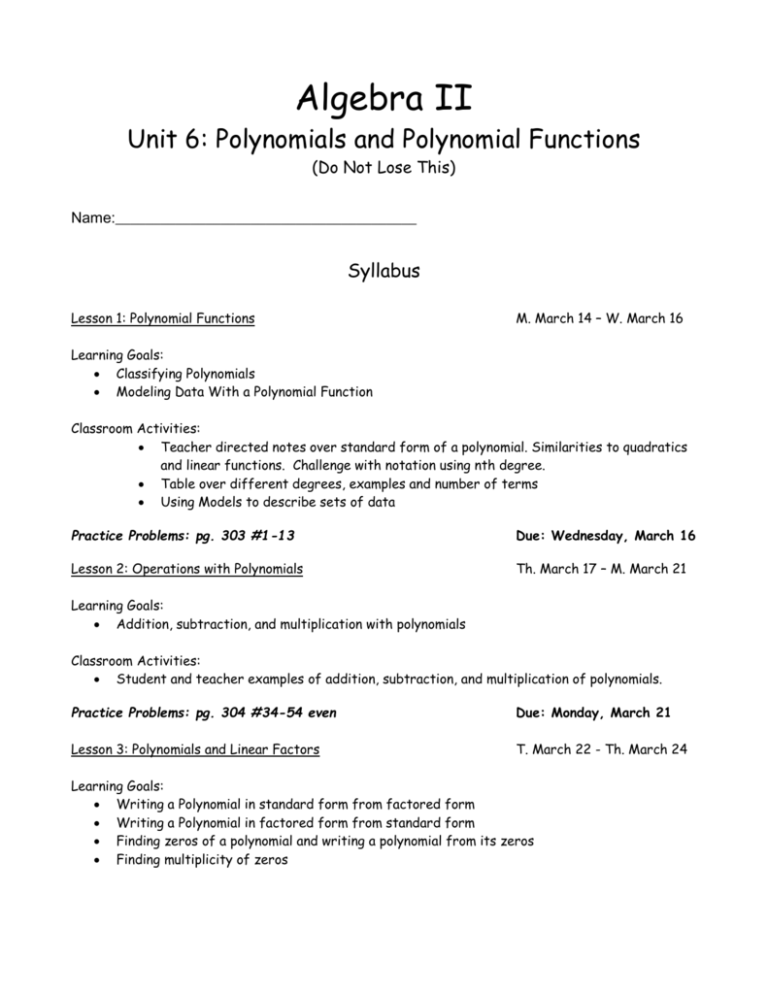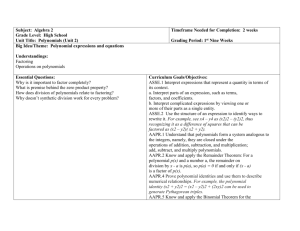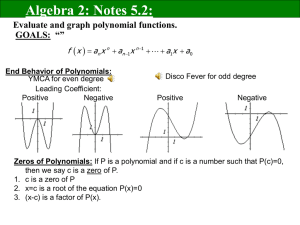Algebra II - Lockland Schools
advertisement

Algebra II
Unit 6: Polynomials and Polynomial Functions
(Do Not Lose This)
Name:________________________________________
Syllabus
Lesson 1: Polynomial Functions
M. March 14 – W. March 16
Learning Goals:
Classifying Polynomials
Modeling Data With a Polynomial Function
Classroom Activities:
Teacher directed notes over standard form of a polynomial. Similarities to quadratics
and linear functions. Challenge with notation using nth degree.
Table over different degrees, examples and number of terms
Using Models to describe sets of data
Practice Problems: pg. 303 #1-13
Due: Wednesday, March 16
Lesson 2: Operations with Polynomials
Th. March 17 – M. March 21
Learning Goals:
Addition, subtraction, and multiplication with polynomials
Classroom Activities:
Student and teacher examples of addition, subtraction, and multiplication of polynomials.
Practice Problems: pg. 304 #34-54 even
Due: Monday, March 21
Lesson 3: Polynomials and Linear Factors
T. March 22 - Th. March 24
Learning Goals:
Writing a Polynomial in standard form from factored form
Writing a Polynomial in factored form from standard form
Finding zeros of a polynomial and writing a polynomial from its zeros
Finding multiplicity of zeros
Classroom Activities:
Students will practice foiling to write a polynomial in standard form from factored form.
Teacher will direct students how to factor out the GCF of a 3rd degree polynomial, then
factor the subsequent quadratic.
The teacher will revisit the x-intercepts of a parabola and how they relate to the solution to
a quadratic equation, and how this process and concept also applies to the graph of a
polynomial and polynomial equation.
The teacher will instruct students how the factored form of a polynomial yields the zeros of
the function and gives the multiplicity of the zeros.
Practice Problems: pg. 311 #1-36
Quiz:
Lesson 1 through Lesson 3
Classifying Polynomials
Modeling Data With a Polynomial Function
Addition, subtraction, and multiplication with polynomials
Writing a Polynomial in standard form from factored form
Writing a Polynomial in factored form from standard form
Finding zeros of a polynomial and writing a polynomial from its zeros
Finding multiplicity of zeros
Lesson 4: Dividing Polynomials
Due Friday March 25
Friday. March 25
M. April 4 – T. April 5
Learning Goals:
Using Long division to Divide Polynomials and checking factors (also check zeros)
Using Synthetic Division to divide polynomials
Classroom Activities:
The teacher will directly instruct students how to divide polynomials by using long division and
use long division to check to see if a polynomial is a factor.
Once students have completed long division, each student will take notes individually over
synthetic division, and complete examples of synthetic division.
Practice Problems: (Monday) pg. 318 # 1-11 odd
(Tuesday) pg. 318 #14-24 even, 34, 40
Due Tuesday April 5
Due Wed. April 6
Lesson 5: Graphing Polynomials
W. April 6 – F. April 8
Learning Goals:
Graphing to solve polynomials (Geogebra)
Factoring Sum and Difference Cubes
Solving a Polynomial Equation using Sum and Difference Cubes
Classroom Activities:
Wednesday – Laptop cart, each student will have a laptop and will use Geogebra to graph
several different polynomial functions, and will find the roots and extrema of each function.
Thursday – The teacher will teach students the sum and difference of Cubes and use those, in
addition to factoring or the quadratic equation, as well as transforming 4th degree polynomials
into 2nd degree polynomials to solve polynomial equations.
Friday – Laptop cart, Graphing Polynomial functions to find solutions to equations.
Practice Problems: (Thursday) pg. 324 # 16-28 even
Due: Friday, April 7
Lesson 6: Important Theorems Regarding Roots of Polynomials
M. April 11 – T. April 12
Learning goals
Understanding Rational Root Theorem, Irrational Root Theorem and imaginary Root Theorem
Writing a Polynomial from its roots
Classroom Activities
Jigsaw Activity – Students will be in groups of three. Each student in the group will be
charged with taking notes on and explaining one of the three theorems to the other members
of the group. (Starting on pg. 329)
Students will then work with the other members of the group to write a polynomial equation
from its roots from pg. 332 Example 5.
Practice Problems: (Tuesday) pg. 333 #2, 3, 4, 8, 13-24
Due End of Class Tuesday April 12
Reviewing Polynomials and Polynomial Functions
Small group work on Review Activity
pg. 353 #1-4, 6-10, 13-16, 20 (long), 21 (short), 22, 34, 37, 40
Test:
W. April 13 – Th. April 14
Unit 6 Polynomials and Polynomial Functions
Friday, April 15
Classifying Polynomials
Modeling Data With a Polynomial Function
Addition, subtraction, and multiplication with polynomials
Writing a Polynomial in standard form from factored form
Writing a Polynomial in factored form from standard form
Finding zeros of a polynomial and writing a polynomial from its zeros
Finding multiplicity of zeros
Using Long division to Divide Polynomials and checking factors (also check zeros)
Using Synthetic Division to divide polynomials
Factoring Sum and Difference Cubes
Solving a Polynomial Equation using Sum and Difference Cubes
Understanding Rational Root Theorem, Irrational Root Theorem and imaginary Root Theorem
Writing a Polynomial from its roots
Self Assessment
My Copy
Scale: 1 – 4
Name:___________________________
I will be able to:
Learning Goals
Classifying Polynomials
Model Data With a Polynomial
Function
Add, subtract, and multiply with
polynomials
Write a Polynomial in standard
form from factored form
Write a Polynomial in factored
form from standard form
Find zeros of a polynomial and
writing a polynomial from its
zeros
Find multiplicity of zeros
Use Long division to Divide
Polynomials and checking factors
(also check zeros)
Use Synthetic Division to divide
polynomials
Factor Sum and Difference
Cubes
Solve a Polynomial Equation using
Sum and Difference Cubes
Understand Rational Root
Theorem, Irrational Root
Theorem and imaginary Root
Theorem
Write a Polynomial from its roots
Date(s) of
Introduction
Level of
Knowledge
(Pre)
Level of
Knowledge
After Lesson
and Practice
Level of
Knowledge
After Quiz
Level of
Knowledge
After Test
Quiz 1 Grade ____
Test Grade: ____
Self Assessment
Mr. Gaertner's Copy
Scale: 1 – 4
Name:___________________________
I will be able to:
Learning Goals
Classifying Polynomials
Model Data With a Polynomial
Function
Add, subtract, and multiply with
polynomials
Write a Polynomial in standard
form from factored form
Write a Polynomial in factored
form from standard form
Find zeros of a polynomial and
writing a polynomial from its
zeros
Find multiplicity of zeros
Use Long division to Divide
Polynomials and checking factors
(also check zeros)
Use Synthetic Division to divide
polynomials
Factor Sum and Difference
Cubes
Solve a Polynomial Equation using
Sum and Difference Cubes
Understand Rational Root
Theorem, Irrational Root
Theorem and imaginary Root
Theorem
Write a Polynomial from its roots
Date(s) of
Introduction
Level of
Knowledge
(Pre)
Level of
Knowledge
After Lesson
and Practice
Level of
Knowledge
After Quiz
Level of
Knowledge
After Test
Quiz 1 Grade ____
Ohio's Benchmarks and Standards
Test Grade: ____
E. Represent and compute with complex numbers.
7. Compute sums, differences, products and quotients of complex numbers.
A. Analyze functions by investigating rates of change, intercepts, zeros, asymptotes, and
local and global behavior.
03. Describe and compare the characteristics of the following families of
functions: quadratics with complex roots, polynomials of any degree, logarithms,
and rational functions; e.g., general shape, number of roots, domain and range,
asymptotic behavior.
04. Identify the maximum and minimum points of polynomial, rational and
trigonometric functions graphically and with technology.
05. Identify families of functions with graphs that have rotation symmetry or
reflection symmetry about the y - axis, x - axis or y = x.
B. Use the quadratic formula to solve quadratic equations that have complex roots.
08. Solve equations involving radical expressions and complex roots.
Geogebra Activity
Name:_________________________
Accessing Geogebra:
1. www.geogebra.org
2. Click “Download”
3. Click “Applet Start”
Take 5 minutes to play around with the buttons.
Section 1: Modeling a Polynomial from points.
Hit “View” and make sure axes and grid are checked.
Step 1: Plot Four Points Using the “New Point” button.
(-1,-2) , (1,2) , (3,-1) , and (4,3)
Step 2: Model Using a Cubic Regression.
a. In the Input box at the bottom of the screen, type: Z={A,B,C,D}
b. This should appear as an Item under Dependent Objects
c. In the command box at the bottom right, select “FitPoly.”
d. Input: FitPoly[Z,3]
e. A graph should appear as well as a function f(x) on the left side of the screen.
f. Record that function here:
Step 3: Find the roots:
a. You now see your function has a name f(x).
b. In the command box, select “Root”
c. To find the roots, Input: Root[f(x)] This will find the three roots of the
polynomial.
d. Record these roots here:
Step 4: Find the Local Maxiumum and Local Minimum
a. In the command box, select “Extremum”
b. To find the Max and Min, Input: Extremum[f(x)].
c. Record the Max and Min here:
Practice Problems:
Part 1:
1. Graph the points: (1,-3) , (-1, -1) , (-2, 1) , (3, 4) , and (5,1).
2. Model using a Quartic Regression from Step 2 on the previous page.
Write the function here:
3. Find the roots of the Polynomials
4. Find the Minimum and Maximums of the function.
Part 2: Plot your own 5 points: (Record just below)
Create a:
Linear Regression,
Quadratic Regression,
Cubic Regression,
Quartic Regression
of the data. Write each function down above next the the appropriate regression.







